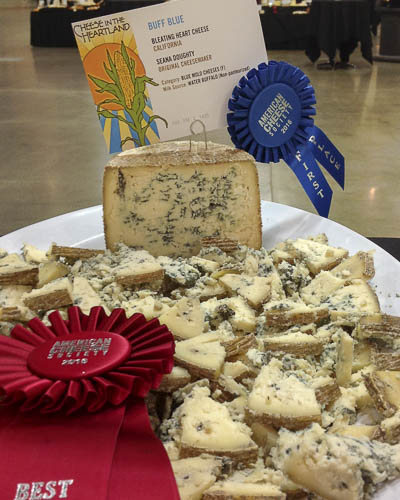For cheesemaker Chris Roelli, last week’s American Cheese Society “Best of Show” ribbon must feel like sweet vindication. Roelli spent years trying to persuade his father to get back in the business after the elder Roelli shuttered his Wisconsin cheese plant in 1991. The family had struggled to make a living producing commodity Cheddar and other low-priced cheese—the type that ends up shredded on a fast-food taco. “When we closed the doors, we were making literally a penny a pound,” Chris told me.
The Roellis continued to sell fluid milk, but Chris’s dad was done with cheese. Fortunately, Chris wasn’t. By 2006, he had talked Dad into trying again with a different business model, focusing on quality rather than quantity. They re-opened the same plant refitted for small-scale production, and Chris held his breath. “I was investing my dad’s savings in a high-risk business that he didn't quite understand,” says Roelli.
Since then, Roelli Cheese Haus has thrived, with unique creations like Dunbarton Blue, a blue-veined Cheddar. Now the big win for Little Mountain, an Appenzeller-style cow’s milk wheel that topped 1,843 competition entries, vaults the cheese overnight to cult status.
Dairy marathon: ACS Festival of Cheeses
Speaking to journalists at the ACS conference in Des Moines, Roelli looked slightly panicked about the orders that would soon flood his inbox. He has only 1,200 pounds (about 80 wheels) of Little Mountain in his aging cellar, at varying stages of maturity. “Please be patient,” he pleaded.
Roelli (pronounced like Raleigh) has been working on Little Mountain for only a couple of years. “I really wanted to make a Swiss-style cheese to come back to our roots,” says Roelli, the great-grandson of a Swiss immigrant cheesemaker. Although Appenzeller inspired him, he has veered off that path a bit. He uses heat-treated Holstein milk (not pasteurized but not fully raw) and, lacking the traditional copper vat, employs copper utensils. He adds minimal culture, relying instead on repeated washing—with simple salt brine at first, then proprietary brine with added bacteria—to generate flavor. After nine months of washing, flipping and waiting, the wheels are released.
Little Mountain doesn’t taste entirely like Appenzeller, but how could it? It’s from southern Wisconsin—prime dairy country but “minus the Alps,” admits Roelli. It’s firm, dense, a bit chewy at first but becoming creamy as its warms on the tongue. The aroma is appropriately nutty, but without the big, beefy, brothy scent typical of many alpine cheeses.
“I find it quite amazing that people can get that close in a couple of years,” said Russell Smith, an eminent Australian cheese judge who told me that he ranked Little Mountain first. This year, his fourth as an ACS judge, Smith said the quality of the competition entries had soared, making it agonizing to choose a champion. At least 10 other cheeses could have prevailed with his blessing, he said.
Until now, the creamery sold Little Mountain primarily to local customers. Roelli expects to have more wheels for retailers in time for the holidays.
Buffalo Gets the Blues
After a near-death experience, California’s Bleating Heart Cheese has roared back. This tiny Marin County creamery took two blue ribbons at ACS (for Shepherdista and Buff Blue), and the water buffalo-milk Buff Blue placed second overall. In beauty-pageant lingo, it’s first runner-up.
“Winning this award was huge for me,” said a teary cheesemaker Seana Doughty. “As many know, our company nearly went out of business following a recall in 2014. We’ve been working really hard to come back from that.”
First runner-up: Bleating Heart Buff Blue
A neighboring farmer with extra water buffalo milk persuaded Doughty to try making cheese with it. A normal person would make mozzarella. Doughty, who loves insurmountable hurdles, chose blue. She had no clue how to make a buffalo blue, and her consultants didn’t either. The high-fat milk makes such dense cheese that it’s hard for blue mold to grow.
The wheel she submitted for competition was five months old, with plentiful blue veining, a rich, toasty, saltine-cracker aroma and a deeply savory flavor. Doughty suggests enjoying Buff Blue with honey and an imperial Russian stout, like North Coast Brewing’s Old Rasputin.
After the trauma of the recall, the blue ribbons felt like redemption. “I finally feel like I can say I’m a good cheesemaker,” says Doughty. Look for Buff Blue in California at Bi-Rite, Cheese Plus, Little Vine, Mission Cheese and Union Larder (San Francisco); Cowgirl Creamery (Pt. Reyes); Big John’s Market (Healdsburg); Oliver’s Market Stony Point (Santa Rosa); Petaluma Market (Petaluma); Nugget Markets; and some Northern California Whole Foods; and Central Bottle Wine & Provisions in Cambridge, Mass.
2016 American Cheese Society Blue-Ribbon Winners from California
Barinaga Ranch Baserri
Bellwether Farms Blackstone (featured recently in Planet Cheese)
Bleating Heart Buff Blue and Shepherdista
Cowgirl Creamery Red Hawk
Cypress Grove Fromage Blanc and Bermuda Triangle
Fagundes Old-World Cheese Hanford Jack
Karoun Dairies Mediterranean Labneh and Gopi Indian Yogurt
Laura Chenel’s Taupinière and marinated Cabécou
Marquez Brothers Queso Panela Tray
Redwood Hill Plain Goat Milk Kefir
Rumiano Dry Monterey Jack and Organic Smoked Mozzarella
Sierra Nevada Organic Jack-Baby Bella Mushroom, Capretta Goat Yogurt and Graziers Grass-Fed European Style Butter
Find the full list of winners here.



